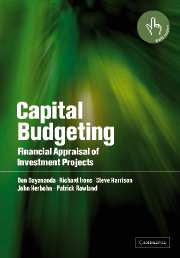Book contents
- Frontmatter
- Contents
- List of figures
- List of tables
- Preface
- 1 Capital budgeting: an overview
- 2 Project cash flows
- 3 Forecasting cash flows: quantitative techniques and routes
- 4 Forecasting cash flows: qualitative or judgemental techniques
- 5 Essential formulae in project appraisal
- 6 Project analysis under certainty
- 7 Project analysis under risk
- 8 Sensitivity and break-even analysis
- 9 Simulation concepts and methods
- 10 Case study in financial modelling and simulation of a forestry investment
- 11 Resource constraints and linear programming
- 12 More advanced linear programming concepts and methods
- 13 Financial modelling case study in forestry project evaluation
- 14 Property investment analysis
- 15 Forecasting and analysing risks in property investments
- 16 Multinational corporations and international project appraisal
- References
- Index
4 - Forecasting cash flows: qualitative or judgemental techniques
Published online by Cambridge University Press: 14 May 2010
- Frontmatter
- Contents
- List of figures
- List of tables
- Preface
- 1 Capital budgeting: an overview
- 2 Project cash flows
- 3 Forecasting cash flows: quantitative techniques and routes
- 4 Forecasting cash flows: qualitative or judgemental techniques
- 5 Essential formulae in project appraisal
- 6 Project analysis under certainty
- 7 Project analysis under risk
- 8 Sensitivity and break-even analysis
- 9 Simulation concepts and methods
- 10 Case study in financial modelling and simulation of a forestry investment
- 11 Resource constraints and linear programming
- 12 More advanced linear programming concepts and methods
- 13 Financial modelling case study in forestry project evaluation
- 14 Property investment analysis
- 15 Forecasting and analysing risks in property investments
- 16 Multinational corporations and international project appraisal
- References
- Index
Summary
In a perfect world, all cash flows associated with a project would be known with certainty. However, this obviously is not the case, and it is common for estimates of parameters determining cash flows to be derived by a number of techniques. In Chapter 3, the importance of forecasting cash flows was discussed and a number of quantitative means of estimating cash flows were outlined.
Quantitative forecasting techniques can be used when (1) past information about the values being forecast is available, and (2) this information can be quantified. Past information is not, however, always available or relevant. For example, for a new product, there are no data on sales on which to base estimates of future sales. Similarly, past sales of a product might not be relevant if a competitor launches a new product with superior features or performance. In other situations, there is insufficient time to obtain data or use quantitative techniques, or circumstances are changing so rapidly that a statistically based forecast would be of little guidance. Even when statistical techniques are available there is strong evidence that human judgement is the overwhelming choice of managers for forecasting. Further, managers appear to be more comfortable dealing with their own judgements or with those of a colleague, than with forecasts generated via a computer package and lacking transparency. Even when quantitative techniques are used, estimates may be combined with qualitative judgements, or supplemented, reviewed or screened by subjecting them to qualitative judgements.
- Type
- Chapter
- Information
- Capital BudgetingFinancial Appraisal of Investment Projects, pp. 55 - 73Publisher: Cambridge University PressPrint publication year: 2002



